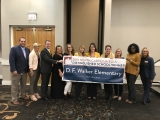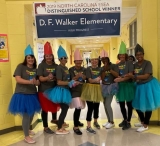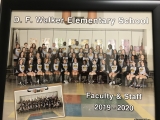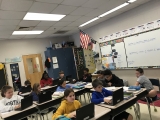-
Category 2
Selected in 2019
-
Grades: 3 - 5
School Setting: rural
Town Population: 15
Student Enrollment: 435
Student Demographics:
Black/African American: 45%
Teacher/Student Ratio: 1:16
White/Caucasian: 30%
Hispanic: 10%
Hawaiian/Pacific Islander: 0%
Asian: 0%
Native American: 0%
Other: 15%
% Reduced Lunch: 72%
% ELL Learners: 4%
Founded: 2001 -
PRINCIPAL:
Linda White -
CONTACT:
125 sandy ridge road
edenton, NC 27932
252-221-4151
lwhite@ecps.k12.nc.us
D.F. Walker Elementary School
edenton, NC
All Thrive in the DFW Hive!
- Describe specific programs in place to ensure that families are involved in the success of your school and students.
- Surveys are conducted and stakeholders are invited to School Improvement and Board meetings to provide feedback on programs. We have key partnerships to enhance performance and increase parent involvement: Chowan Food Pantry (Book Bag Buddies for food each Friday to ensure weekend food), Ministers’ Council (clothes), and Sisters of Strength (backpacks with supplies). Juvenile Justice establishes a male mentor group. Curriculum nights, parent teacher conferences, parent workshops are held and our Summer Book Bus equips parents with resources. Parent conferences are held in a community center within walking distance to many homes. We offer enrichment opportunities that include Goodies with Grandparents, Muffins with Moms, Doughnuts with Dads, Watch D.O.G.S., and Bring Your Family to School Week. Events include: Book Character Day, Kindness Day, Kids and Cops, Ruritan Dictionary Project and One School One Book. We advertise using our all call system, social media, and newsletters.
- Describe the most successful activity your school has initiated to strengthen ties to your community.
-
Our parent engagement nights have been the most successful activity that we have initiated to bring our parents and families to the school. We have parent engagement nights that center around a theme of either literature or STEAM related subjects. On our literature nights each class or grade level chooses a theme or a particular book to concentrate. The students will then create projects based on the books that they have read. In the past some of our groups have produced plays, created movie trailers, and even created traditional book report projects like dioramas. Our STEAM night is completely centered on infusing both math and science together in a carnival experience. Every classroom teacher creates a booth where families may come and experience science experiments and math games.
At each of our parent engagement nights we offer parents strategies to take home so that they may assist their child with school work to become more successful. - Describe your philosophy of school change or improvement.
- Our slogan, “All Thrive in the DFW Hive,” is highly evident in our strong culture reinforced by academic, social and behavioral Multi Tiered Systems of Support. Our team established a school-wide Positive Behavior Intervention and Support (PBIS) matrix for behavior expectations. School-wide, classroom and individual incentives recognize and promote positive behaviors. PBIS has helped decrease the referral rate by 80%, leading to a four-year trend of improved achievement and growth. With this noted, the philosophy of school change or improvement rests in the overall concept of 'believing and achieving.' They go hand in hand! Once basic needs are met and relationships are established, the academics will follow, leading a positive shift or change in the school culture and overall improvement strategies. We believe all students can learn through personalized education and empowerment. By working together consistently, school improvement is an attainable goal!
- What are your school’s top two goals for the next year?
- While there are more than two goals for next year, the top two include taking the school and students/staff to the 'next level.' This includes a more narrowed focus in the way we view and analyze data, as well as a more targeted/differentiated approach to teaching and learning. By looking at the data, we will internalize patterns with trends from grade to grade and year to year, as well as review individual numbers as compared to goals/objectives/standards. Instruction will be prescribed based on individual needs and targeted with a balanced blend of best practices that meet individual learning needs and styles. Student ownership will be a goal in which students and their families will be more in-tune with their assessment data and reports. They will set goals to reach and establish plans to ensure their goals are met. This is a continuation of the foundation that has been set already and will only grow as new staff members embrace the concept and students work vertically.
- What is the single most important factor in the success of your school that others could replicate?
- Students are identified for initiatives based on a cycle of data collection, disaggregation and reporting which provides a roadmap of targets. Sources include daily, weekly, quarterly, and annual diagnostic assessments, discipline, parent and student surveys, Roadmap of Need, End of Grade Assessment and EVAAS growth data. Standards based assessment data is disaggregated to determine student mastery of curriculum standards. Students are placed into small groups and receive daily, targeted enrichment or remediation. Students who need small group remediation receive instruction through a support cycle (reteach, practice, reassess) using research based resources. Students not progressing receive intensive small group or one on one interventions. Enrichment small groups receive targeted instruction at or above their level. Teachers track students’ data in a Google Spreadsheet, allowing continuous evaluation of school progress. Teachers meet with administration for data conferences.
- Describe the program or initiative that has had the greatest positive effect on student achievement, including closing achievement or opportunity gaps, if applicable.
- All students receive tiers of high quality instructional support. DFW offers 90-minute blocks where core instruction is differentiated and tightly aligned to content standards. We use components of balanced literacy, evidence based math practices, and a strong focus on tiered vocabulary using the strategies of Marzano. Core instructional resources, aligned with NC Standards include: Wonders Reading, EngageNY Math with NC Tools for Teachers, and StemScopes Science. A system for data analysis at the school, grade, and individual student level is operationalized through PLCs. School administration holds data conferences with each teacher to analyze every child’s progress, and implement appropriate goals and interventions. Targeted, small-group instruction, tailored to individual student needs, provides scaffolding and reteach using resources such as Leveled Literacy Intervention and i-Ready. Adaptive digital platforms such as Freckle and Moby Max to provide intensive interventions.
- Explain how ESEA federal funds are used to support your improvement efforts.
- In a small, rural district ESEA federal funds are essential to the daily operations of the school - including academic, socially, emotionally and physically. The funds are used to enhance opportunities for students of poverty and a wide range of diversities. The funds are dispersed to the school from the system's central office after collaborative discussions with district administrators, school-based teams and community input. Together, the variety of stakeholders are surveyed and opportunities are allowed for discussion on strategic planning. The funds are then used to support teacher and teacher assistant salaries, instructional supplies, materials and supplies and staff development. All of these initiatives are in support of the school's School Improvement Plan as well as the system's Strategic Plan.
- Identify the critical professional development activities you use to improve teaching and student learning.
- The (PD) framework has three tiers; Whole School PD, Grade Level Professional Learning Communities (PLCs), and Optional Differentiated PLCs. Tier One whole school professional development provides data driven research based PD which creates a culture of continuous learning and implements an instructional continuum for students across our school. In tier two, staff attend weekly grade level PLCs where the research based PD topic is continued with a more targeted approach for the specific needs of the grade level data. In tier three, we offer weekly school-wide Optional Differentiated PLCs. The PD is differentiated by curriculum and or skill level (beginning, intermediate, advanced) to ensure all individual staff are receiving the support they need. PD content is carefully selected by analyzing current needs in student assessment results, whole child data, teacher walkthrough and observation data, as well as staff surveys and a school wide PD survey.
- Describe how data is used to improve student achievement and inform decision making.
- A system for data collection, disaggregation, and analysis at the school, grade, and individual, student level is operational through PLCs (Professional Learning Communities) and school administration. School administration holds data conferences with each teacher to analyze every child's progress, and implement appropriate goals and interventions. Targeted, small-group instruction, tailored to individual student needs, provides scaffolding and reteach using resources such as Leveled Literacy Intervention and i-Ready. Adaptive digital platforms such as Freckle and Moby Max, as well as resources from the Florida Center for Reading, and Intervention Central are used to provide intensive interventions. These are selected by analyzing the needs present in our data sources. The conversations are held between administration and teachers, as well as teachers with teachers, and then teachers with parents and students. Collectively, individualized goals are mastered through targets set.
- Describe your school culture and explain changes you’ve taken to improve it.
- Our school changed our PBIS program four years ago. We incorporated a three tiered system where at every level a student is rewarded for good behavior and doing the right thing. At the first tier the students must work together as a class to earn super stings. They earn these by behaving well in their pull-out classes, lunch room, and hallway time. When the class earns 25 stings they can earn rewards ranging from wear a hat to school to even a field trip! At the second stage, students work individually to earn DF Walker dollars that they can spend in our HIVE shop. Students earn their dollars by following the school motto. Our HIVE shop is supplied by donations from our community. The final tier of our PBIS plan is a fluid chart. Each class room has a system where the students can buzz up or down throughout the day. Because it is fluid, they know if they buzz down they can always change their behavior and buzz back up. We have reduced our referral rate by 80% since changing our plan.
Stats
-
Category 2
Selected in 2019
-
Grades: 3 - 5
School Setting: rural
Town Population: 15
Student Enrollment: 435
Student Demographics:
Black/African American: 45%
Teacher/Student Ratio: 1:16
White/Caucasian: 30%
Hispanic: 10%
Hawaiian/Pacific Islander: 0%
Asian: 0%
Native American: 0%
Other: 15%
% Reduced Lunch: 72%
% ELL Learners: 4%
Founded: 2001 -
PRINCIPAL:
Linda White -
CONTACT:
125 sandy ridge road
edenton, NC 27932
252-221-4151
lwhite@ecps.k12.nc.us










